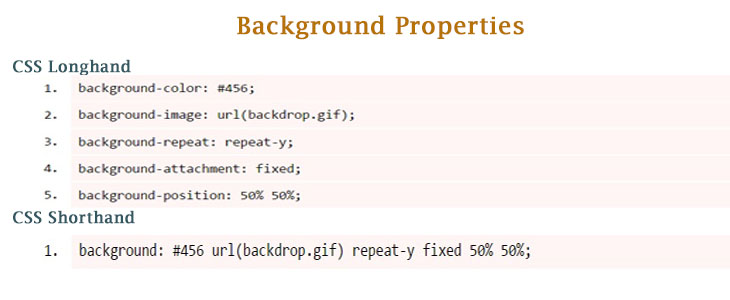reading-notes
Audio, Video, Images
Images
controlling sizes of Images In css
You can control the size of an image using the width and height properties in CSS, just like you can for any other box. Specifying image sizes helps pages to load more smoothly because the HTML and CSS code will often load before the images, and telling the browser how much space to leave for an image allows it to render the rest of the page without waiting for the image to download.Whenever you use consistently sized images across a site, you can use CSS to control the dimensions of the images, instead of putting the dimensions in the HTML.
aligning Images Using css
- There are two ways to align img:
- The float property is added to the class that was created to represent the size of the image.
- New classes are created with names such as align-left or align-right to align the images to the left or right of the page.These class names are used in addition to classes that indicate the size of the image.
img.align-left {
float: left;
margin-right: 10px;}
img.align-right {
float: right;
margin-left: 10px;}
img.medium {
width: 250px;
height: 250px;}
centering Images Using css
- two common ways you can horizontally center an image:
- On the containing element, you can use the text-align property with a value of center.
- On the image itself, you can use the use the margin property and set the values of the left and right margins to auto.
img.align-center {
display: block;
margin: 0px auto;}
img.medium {
width: 250px;
height: 250px;}
background-image
The background-image property allows you to place an image behind any HTML element. This could be the entire page or just part of the page. By default, a background image will repeat to fill the entire box. The path to the image follows the letters url, and it is put inside parentheses and quotes.
body {
background-image: url("images/pattern.gif");}
Or
p {
background-image: url("images/pattern.gif");}
repeating Images
- The background-repeat property can have four values:
- repeat The background image is repeated both horizontally and vertically
-
repeat-x The image is repeated horizontally only
-
repeat-y The image is repeated vertically only.
-
no-repeat The image is only shown once.
background-attachment
The background-attachment property specifies whether a background image should stay in one position or move as the user scrolls up and down the page.
- It can have one of two values:
- fixed The background image stays in the same position on the page.
- scroll The background image moves up and down as the user scrolls up and down the page.

background position
When an image is not being repeated, you can use the background-position property to specify where in the browser window the background image should be placed. This property usually has a pair of values. The first represents the horizontal position and the second represents the vertical.
body {
background-image: url("images/tulip.gif"); background-repeat: no-repeat;
background-position: center top;}

shorthand background
The background property acts like a shorthand for all of the other background properties you have just seen, and also the background-color property. The properties must be specified in the following order, but you can miss any value if you do not want to specify it.

Conclusion: You can specify the dimensions of images using CSS. This is very helpful when you use the same sized images on several pages of your site. Images can be aligned both horizontally and vertically using CSS. You can use a background image behind the box created by any element on a page. Background images can appear just once or be repeated across the background of the box. You can create image rollover effects by moving the background position of an image. To reduce the number of images your browser has to load, you can create image sprites.
Practical Information
The term “search engine optimization” refers to the process of optimizing a website for search engines. In basic terms, it refers to the process of enhancing your website in order to enhance its exposure when consumers use Google, Bing, and other search engines to look for items or services connected to your business. The higher your pages’ exposure in search results, the more likely you are to draw attention and attract new and existing consumers to your company.

Search engine optimization helps visitors find your sites when using search engines. Analytics tools such as Google Analytics allow you to see how many people visit your site, how they find it, and what they do when they get there. To put your site on the web, you will need to obtain a domain name and web hosting. FTP programs allow you to transfer files from your local computer to your web server. Many companies provide platforms for blogging, email newsletters, e-commerce and other popular website tools (to save you writing them from scratch).
Video and Audio APIs
HTML5 video and audio
The <video> and <audio> elements allow us to embed video and audio into web pages.a typical implementation looks like this:
<video controls>
<source src="rabbit320.mp4" type="video/mp4">
<source src="rabbit320.webm" type="video/webm">
<p>Your browser doesn't support HTML5 video. Here is a <a href="rabbit320.mp4">link to the video</a> instead.</p>
</video>
The HTMLMediaElement API
Part of the HTML5 spec, the HTMLMediaElement API provides features to allow you to control video and audio players programmatically — for example HTMLMediaElement.play(), HTMLMediaElement.pause(), etc. This interface is available to both <audio> and <video> elements, as the features you’ll want to implement are nearly identical.